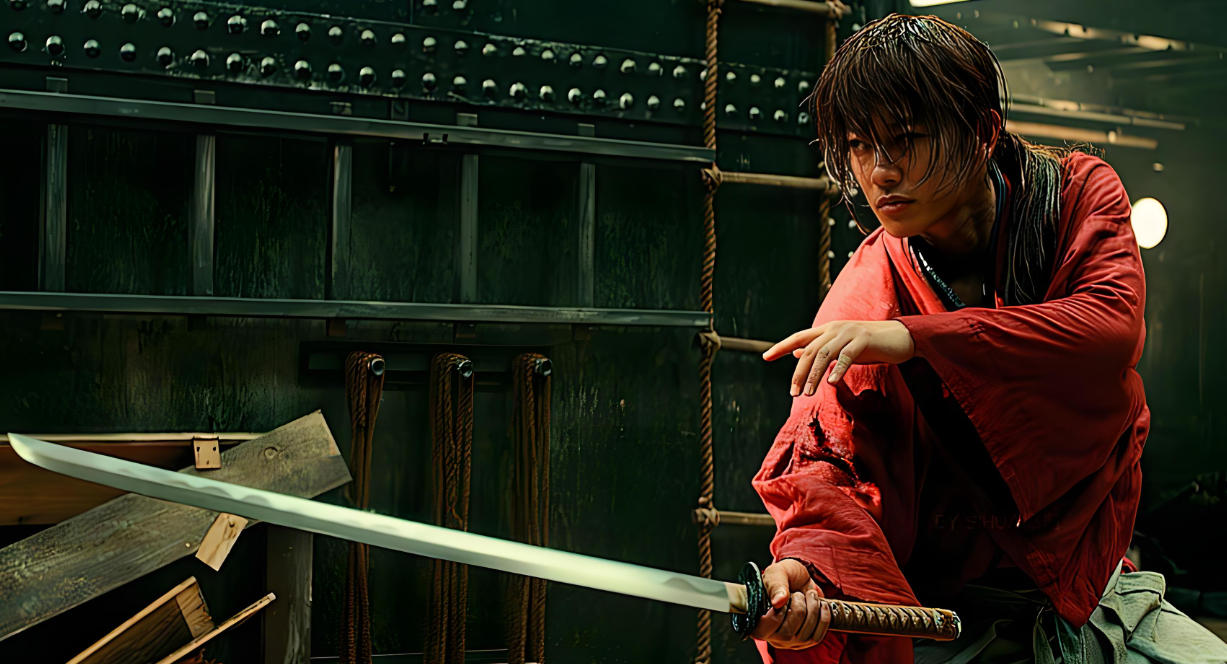Rurouni Kenshin & His Sakabato: Meaning Behind the Reverse Blade Sword

Why Does Rurouni Kenshin Use a Reverse Blade Sword (Sakabato)?
In the history of Japanese anime, Rurouni Kenshin is undoubtedly a classic. The story centers on the protagonist Kenshin Himura, a legendary swordsman once known as the 'Hitokiri Battosai.' After the Meiji Restoration, he lays down his sword and vows never to kill again. His journey of redemption and unwavering conviction is not only reflected in his inner struggles but also embodied in his unique weapon—the Sakabato (Reverse Blade Sword).
Is Rurouni Kenshin Worth Watching?
Absolutely. Rurouni Kenshin combines historical context, rich character development, and thrilling sword battles, making it a must-watch for fans of anime, samurai culture, and meaningful storytelling.
1. Engaging Storyline and Historical Background
Set during the turbulent years of the Meiji Restoration, Rurouni Kenshin follows Kenshin Himura as he transitions from the infamous 'Hitokiri Battosai' to a wandering swordsman seeking redemption. The plot weaves together historical events, samurai culture, and human drama, balancing intense action with heartwarming daily life moments.
2. Unique and Memorable Characters
-
Kenshin Himura: Gentle yet resolute, steadfast in his vow to never kill.
-
Kaoru Kamiya: Strong yet kind, Kenshin’s emotional anchor.
-
Shishio Makoto: A compelling villain whose presence heightens tension and stakes.
Every character is distinct, with clear growth and psychological depth, making them highly engaging for viewers.
3. Stunning Swordsmanship and Action
The anime features sword fights that faithfully reflect traditional Japanese sword techniques. The use of the Sakabato (Reverse Blade Sword) showcases Kenshin’s principle of fighting to protect rather than to kill. The fluid choreography, combined with dramatic music, delivers thrilling and emotionally resonant action scenes.
4. Deep Themes and Meaningful Messages
Beyond being a martial arts anime, Rurouni Kenshin explores themes of redemption, peace, and the human condition. Kenshin’s beliefs and actions encourage viewers to reflect on the true purpose of power, adding cultural and philosophical depth to the story.
I. Kenshin Himura: From Hitokiri to Wanderer
For every true fan of Rurouni Kenshin, the image of the gentle swordsman in a red kimono, carrying his reverse blade sword, is unforgettable. His soft-spoken 'Oro?' always carries a touch of shyness and serenity, yet few realize that this kind-hearted wanderer was once the feared Hitokiri Battosai, a name that struck terror during the chaotic years of the Bakumatsu.
In the turmoil of the Meiji Restoration, young Kenshin’s unmatched swordsmanship and strategic mind made him the deadliest weapon of the revolutionaries. His blade was both a symbol of change and a harbinger of bloodshed. Every draw of his sword was a life-or-death choice. Over time, overwhelmed by the blood on his hands, Kenshin began questioning:
'Is this world really worth changing through killing?'
After the war ended and peace returned, the feared Hitokiri Battosai disappeared from history. The wandering Kenshin Himura began traveling between Kyoto and Edo, no longer serving any faction. He carried only his heavy past and a quest for redemption, silently protecting others along the way.
He replaced his lethal sword with a unique one—the Sakabato (Reverse Blade Sword). With its reversed edge, it could stun enemies but never kill. It symbolizes his separation from the past and embodies his vow to never take a life again. Whenever enemies questioned why he spared lives, Kenshin would calmly respond:
'I am no longer Battosai. My sword exists only to protect.'
His combination of gentleness and unwavering resolve is deeply moving. From his tender days with Kaoru Kamiya to confronting formidable foes like Shishio Makoto, Kenshin remains committed to protecting life. In his eyes, true strength is not for destruction but for safeguarding what is precious.
Fans often say that the Sakabato is more than a weapon—it is an extension of Kenshin’s soul. It carries his past, present, and future—a journey of redemption, conviction, and humanity. Every time he draws it, we witness not just expert swordsmanship but a heart that, though once consumed by darkness, chooses the light.
It is for this reason that Rurouni Kenshin continues to resonate decades later. Kenshin’s blend of gentleness and courage reminds us that true strength lies not in killing, but in letting go of hatred while still protecting others.
II. Sakabato (Reverse Blade Sword): A Sword That Cannot Kill
Among Japanese swords (Japanese Katana) in history and legend, the Sakabato (Reverse Blade Sword) stands out as the most soulful and symbolic. Its significance lies not in sharpness or lethality, but in its design as a weapon that cannot kill, reflecting Kenshin Himura’s commitment to redemption and peace.
Unlike traditional katana swords, the Sakabato’s sharp edge faces inward while the flat side faces outward. This allows Kenshin to execute astonishing sword techniques (Battōjutsu) without taking a life. It is not only a unique weapon but also a symbol of principle:
'True strength should protect, not destroy.'
A Sword Symbolizing Redemption and Protection
In Rurouni Kenshin, the Reverse Blade Sword witnesses Kenshin’s transformation from Hitokiri Battosai to a gentle wanderer. Whether in his decisive battle with Shishio Makoto or confronting Enishi Yukishiro, Kenshin consistently upholds his vow not to kill. Every fallen opponent reflects not arrogance in victory but deep compassion and resolve.
The Sakabato has thus become the most cherished sword among fans. Each hamon and contour tells the story of Kenshin’s journey. As Kenshin himself says:
'The edge of this sword no longer exists to take life. It exists to protect those who live.'
A Collector’s Treasure: Rurouni Kenshin Sword Replicas
Today, among anime enthusiasts and samurai sword collectors, Rurouni Kenshin sword replicas and Kenshin Sakabato replicas are must-have collectibles. Renowned sword-making brands like MangaKatana and COOLKATANA produce high-quality versions as tributes to this timeless masterpiece.
High-end replicas often feature:
-
1095 High Carbon steel or T10 Carbon Steel blades for strength and authenticity
-
Hand Forged (forged katana) construction with clay tempered process for natural hamon patterns
-
Traditional ray skin handles (Samegawa) wrapped in silk ito to perfectly replicate Kenshin’s sword grip
Collectors can not only appreciate the cold elegance of a traditional Japanese sword but also experience the warmth of Kenshin’s spirit. Whether for display, collection, or cosplay, a Sakabato replica represents more than a weapon—it embodies a legacy of conviction and redemption.
The Modern Significance of the Sakabato
Today, the Sakabato (Reverse Blade Sword) is more than just a fictional weapon—it is a symbol of conviction.
It reminds us that the true meaning of strength lies not in conquest, but in restraint and protection.
Just as Kenshin chose his path—he laid down the sword of slaughter, yet never abandoned his duty to protect.
For countless fans of Rurouni Kenshin, owning a Sakabato (Kenshin Sword) is not just about collecting a classic item; it is about inheriting a spirit.
It reminds us of the core truth:
'A sword’s edge can change the world, but a gentle heart can save lives.'
III. The Symbolism of the Sakabato: Embodying Redemption and Conviction
Unlike the Nichirin Blades in Demon Slayer or the Zanpakuto in Bleach, Kenshin’s Sakabato (Reverse Blade Sword) is not defined by raw power. Instead, it represents a philosophy:
'True strength is not in the art of killing, but in the courage to refuse to kill.'
This principle runs throughout the entire Rurouni Kenshin series. Whether confronting Shishio Makoto or protecting Kaoru Kamiya, Kenshin upholds his vow through the Sakabato, demonstrating the true spirit of a samurai.
IV. Hand-Forged Rurouni Kenshin Sakabato Katana | 1095 High Carbon Steel Full Tang Sword
Inspired by the iconic sword of Kenshin Himura in the classic anime Rurouni Kenshin, this hand-forged Japanese katana is not only a collectible work of art but also a symbol of conviction—strength used for protection, not killing.
Unique Design – Reverse Blade, Symbol of Redemption
Unlike traditional katanas, this sword’s sharp edge is reversed onto the spine, while the flat side faces outward, reflecting Kenshin’s vow to never kill.
Every curve and blade detail evokes his journey from the deadly Hitokiri Battosai to the gentle wandering swordsman.
This is more than a sword—it is a continuation of legend, a blade dedicated to safeguarding peace.
Premium Forging and Heat Treatment
The Sakabato is crafted from 1095 High Carbon Steel, reinforced through multiple folded steel forging steps for exceptional resilience.
After forging, the blade undergoes meticulous hardening (quenching) and tempering:
-
Quenching (Hardening)
The blade is heated to red-hot temperatures (~800–900°C) and quickly cooled in oil, rapidly solidifying the carbon structure.-
Enhances hardness for a sharp edge that stays durable
-
Improves wear resistance, extending the blade’s lifespan
-
-
Tempering
After quenching, the blade is reheated to 200–250°C and slowly cooled.-
Relieves internal stresses from quenching
-
Maintains toughness and elasticity to prevent brittleness
-
Perfectly reveals the subtle hamon pattern, combining beauty and function
-
This clay-tempered process not only enhances performance but also makes each blade unique, showcasing the artistry of traditional Japanese sword-making.
Traditional Aesthetics and Craftsmanship
The handle is wrapped with genuine ray skin (Samegawa) and overlaid with silk ito, offering a comfortable and secure grip.
The lacquered wooden scabbard (Saya) is hand-polished in multiple layers for a smooth finish, paired with an iron tsuba, perfectly replicating the classic look from the anime.
A Symbol of Collection and Conviction
The Rurouni Kenshin Sakabato Replica is cherished not only by anime fans but also by collectors and enthusiasts of samurai culture.
Whether for display, cosplay, or as a symbolic collectible, it embodies the samurai spirit of 'gentleness overcoming strength, compassion controlling violence.'
Holding this Sakabato is not just owning a katana—it is feeling Kenshin’s gentle yet unwavering spirit of protection.
Hand Forged Rurouni Kenshin Sakabato Katana Japanese Sword 1095 Steel Reversed Cutting Edge Sharp Full Tang
V. The Influence of Rurouni Kenshin and the Legacy of Its Spirit
Rurouni Kenshin is more than a shonen anime; it is a human story about peace, conviction, and redemption. Kenshin’s image has earned immense popularity in Japan and worldwide, making the Sakabato (Reverse Blade Sword) a symbol of principle.
In modern society, more and more people commemorate the series by collecting or purchasing Rurouni Kenshin Sword Replicas. Whether for display, collection, or as an anime gift idea, they reflect Kenshin’s belief in protecting with the sword rather than killing.
Conclusion: One Sword, One Conviction, One Wanderer’s Legend
The story of Rurouni Kenshin teaches us that true strength does not lie in being a merciless killer, but in holding onto one’s principles amidst blood and fire.
The Sakabato (Kenshin Reverse Blade Sword) is the embodiment of conviction and redemption.
Whether you are a devoted fan of Rurouni Kenshin or a collector of samurai culture, a Rurouni Kenshin Reverse Blade Sword Replica is a treasure worth owning.
It is not only a finely crafted sword but also an eternal legacy of benevolence and courage.










